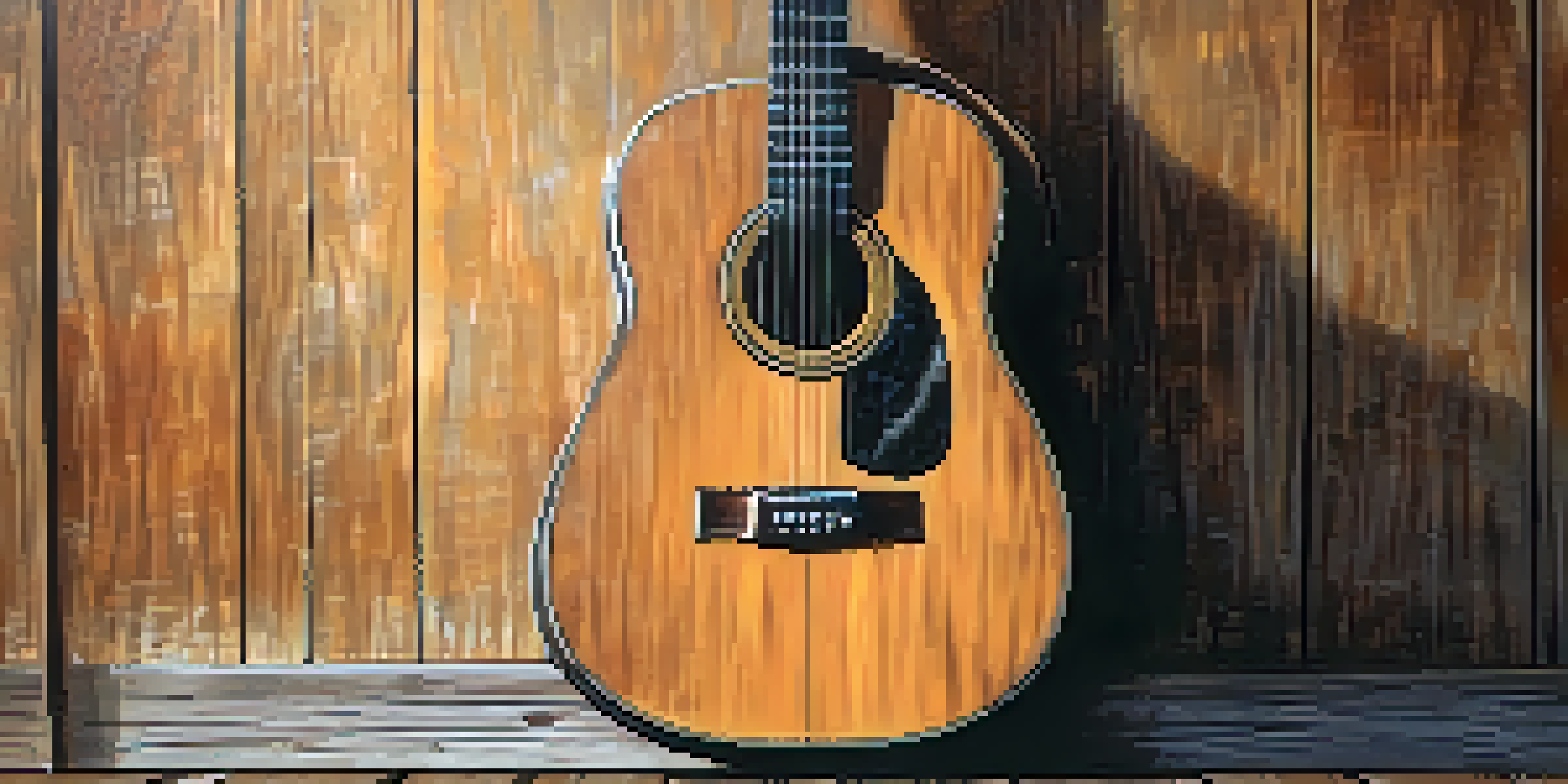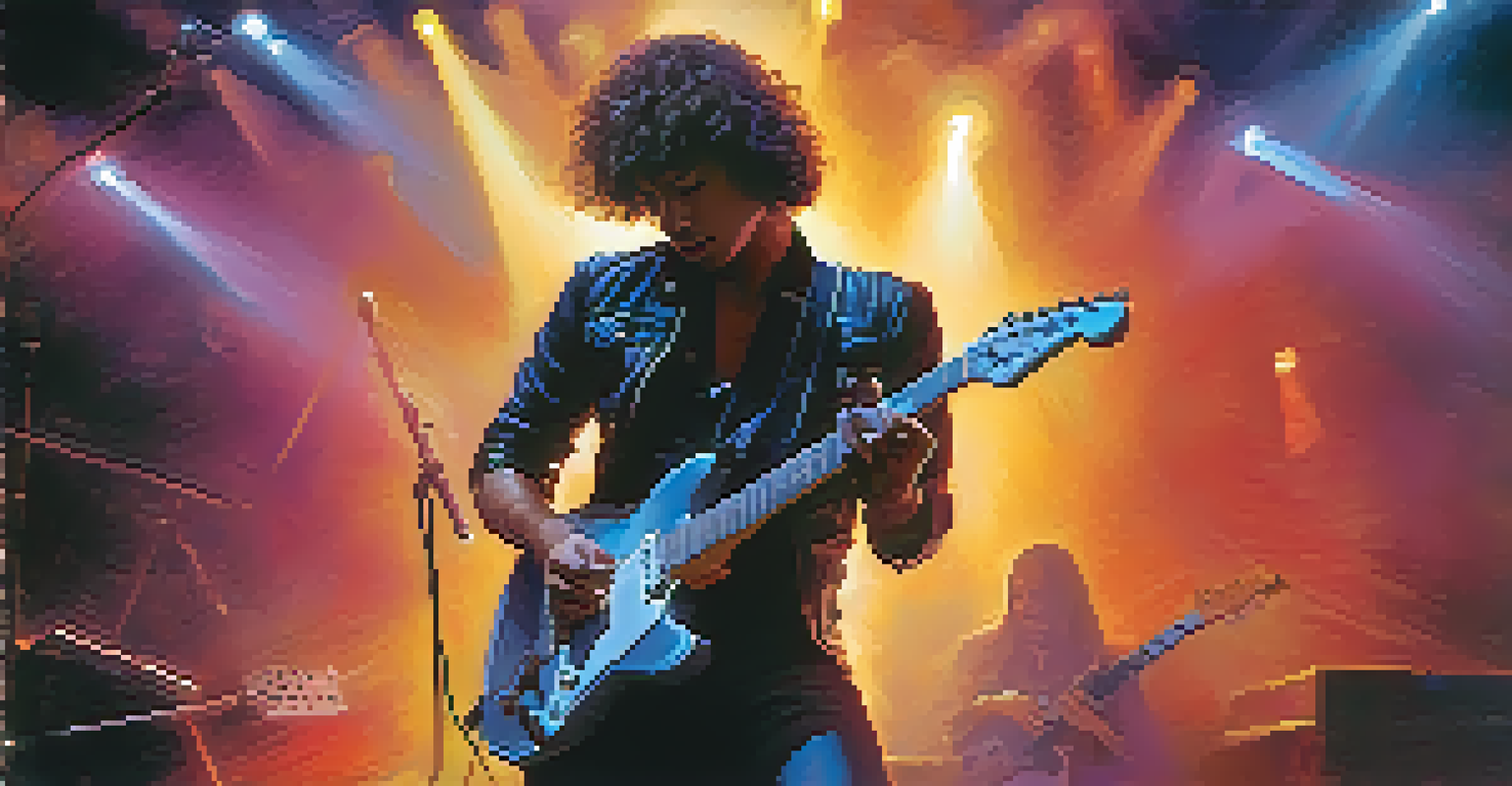Guitar as a Character: Its Role in Film Scores

The Guitar: More Than Just an Instrument in Film Scores
In film scoring, the guitar often transcends its role as a mere instrument; it becomes a character in its own right. Whether strumming softly in a romantic scene or wailing in an action sequence, the guitar can convey emotions that words sometimes cannot. Its versatility allows composers to use it in various genres, from drama to horror, enhancing the storytelling experience.
The guitar is a powerful instrument that can convey emotions that words sometimes cannot.
Think about iconic film moments, like the haunting notes in 'The Good, the Bad and the Ugly.' The guitar's twang not only sets the mood but also evokes a sense of nostalgia and tension. This ability to evoke feelings makes it an indispensable part of a film's sonic landscape.
By integrating the guitar into their scores, composers create a deeper connection between the audience and the film. This connection transforms the guitar into a storytelling device, allowing it to communicate subtleties that visuals alone may miss.
The Emotional Palette of the Guitar in Cinematic Storytelling
One of the most powerful aspects of the guitar is its emotional range. From the gentle strumming of an acoustic guitar to the electrifying riffs of an electric guitar, each sound can evoke different feelings. For instance, a soft acoustic melody might underscore a tender love scene, while a distorted electric riff could heighten the drama of a climactic confrontation.

This emotional versatility allows filmmakers to use the guitar to underscore key narrative moments. It can guide the audience's feelings, subtly nudging them toward empathy, excitement, or suspense. The guitar's presence in a score can make a scene resonate long after the credits roll.
Guitar as a Character in Film
In film scoring, the guitar transcends its role as an instrument, becoming a storytelling device that conveys emotions beyond words.
Moreover, the emotional depth brought by the guitar is often heightened by its cultural associations. For example, a Spanish guitar may evoke passion and romance, while a blues riff might conjure feelings of heartache and longing, adding layers to the story being told.
Iconic Film Scores Featuring the Guitar
Certain film scores have become iconic not just for their compositions but for their use of the guitar. Think of 'Pulp Fiction,' where surf rock guitar riffs play a pivotal role in establishing the film's unique vibe. The electric guitar's punchy sound perfectly complements the film's edgy, cool aesthetic.
Music is the shorthand of emotion.
Another notable example is 'The Shawshank Redemption,' where the acoustic guitar brings warmth and hope to the otherwise somber narrative. The use of the guitar in this score elevates critical moments, making them unforgettable for viewers. It's as if the guitar is narrating the emotional journey alongside the characters.
These memorable scores highlight how the guitar can become synonymous with a film's identity, leaving an indelible mark on popular culture. They show that sometimes, it's not just the story that captivates audiences; it's how that story is told through the music that accompanies it.
The Guitar's Role in Setting the Film's Tone
The initial notes of a film score can set the tone for everything that follows, and the guitar is often at the forefront of this auditory introduction. A well-placed guitar solo can instantly transport the audience into a specific emotional state, whether it be excitement, fear, or nostalgia. This sets the stage for the narrative, preparing viewers for the journey ahead.
For instance, in horror films, dissonant guitar chords can create an unsettling atmosphere, making viewers feel uneasy before anything even happens on screen. In contrast, an uplifting guitar melody in a family film can signal warmth and adventure. The guitar, therefore, plays a crucial role in establishing context before any dialogue is spoken.
Emotional Versatility of the Guitar
The guitar's diverse sounds can evoke a wide range of emotions, allowing filmmakers to enhance key narrative moments effectively.
As the film progresses, the guitar can adapt to shifting tones, providing an aural cue for the audience. This fluidity helps maintain engagement, ensuring that viewers remain emotionally invested in the story.
Cultural Connections: Guitars and Global Cinema
The guitar is a global instrument, with variations present in many cultures, and this makes it a powerful tool in international cinema. Filmmakers often use local guitar styles to enhance authenticity and connect with the cultural context of their stories. This connection can deepen the audience's immersion in the film's setting and themes.
For example, the use of flamenco guitar in Spanish films adds a layer of cultural richness, evoking the passionate spirit of the Mediterranean. Similarly, the sitar or oud can bring an Eastern flavor to Western audiences, making the film's setting feel more authentic and engaging.
By incorporating culturally significant guitar styles, filmmakers broaden their storytelling tools and connect with diverse audiences. This practice not only showcases the versatility of the guitar but also highlights the importance of cultural representation in film.
The Process of Integrating Guitar into Film Scores
Integrating guitar into film scores involves careful consideration by composers, who must think about how the instrument fits into the overall soundscape. The choice of guitar type—acoustic, electric, or even bass—can dramatically change the score's feel and emotion. This decision-making process often begins with understanding the film's themes and character arcs.
Composers may spend hours experimenting with different guitar sounds to find the perfect fit for a scene. This often involves layering various guitar tracks, adjusting effects, and exploring different playing techniques to create the desired atmosphere. The goal is to ensure that the guitar not only complements but enhances the visual storytelling.
Cultural Impact in Global Cinema
By incorporating local guitar styles, filmmakers enrich their stories and deepen audience immersion, showcasing the instrument's cultural significance.
In some cases, filmmakers collaborate closely with guitarists to achieve the right sound. This collaborative approach can lead to innovative uses of the instrument, allowing for a more personalized and impactful score that resonates with audiences on a deeper level.
The Future of Guitar in Film Music
As technology evolves, so does the way we experience music in film, including the use of the guitar. Digital audio workstations and advanced recording techniques allow for new creative possibilities, enabling composers to push the boundaries of how the guitar is used. This evolution opens up exciting opportunities for experimentation and innovation in film scores.
Moreover, the rise of independent filmmaking has led to a resurgence of interest in the guitar, especially among younger composers who are eager to explore its expressive potential. These artists are blending traditional guitar sounds with modern genres, creating unique soundscapes that reflect contemporary culture.

Looking ahead, we can expect to see the guitar continue to play a vital role in film music, adapting to new trends while retaining its emotional core. As filmmakers and composers collaborate to tell their stories, the guitar will remain an essential character in the cinematic experience.